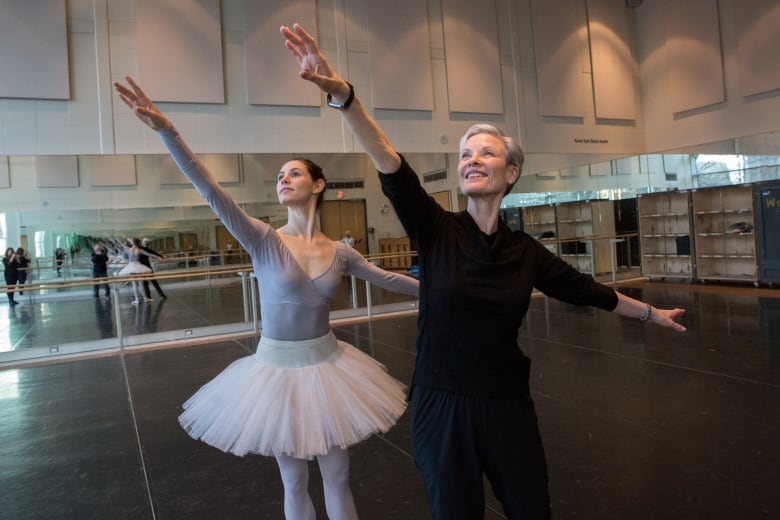When Karen Kain took over as artistic director of the National Ballet of Canada in 2005, she was determined to make sure her dancers had access to the care and support that she never had.
Kain, one of Canada's most prolific ballet dancers, ended her 16-year term at the helm of the prestigious ballet company on Wednesday. She says she hopes she left the institution a more diverse, accessible and supportive place than she found it.
"There's new generations of artistic directors everywhere, and we want to take the best possible care we can of our dancers, both physically and mentally," Kain told As It Happens guest host Nil Köksal.
"We didn't have any of that when I was a young dancer."
Listen: Karen Kain on retiring from the National Ballet of Canada:
15:10Karen Kain talks to As It Happens on her last day as artistic director
Kain first joined the National Ballet of Canada in 1969 as a member of its Corps de Ballet. She was promoted to principal dancer in 1971 following her well-received debut as Odette/Odile in Swan Lake.
Soon, she rose to international stardom, and performed on stages in Moscow, France, London and Vienna.
But in the '80s, she found herself buckling under the weight of her newfound fame.
"I got sort of famous very quickly and there was a lot of feeling that I didn't really deserve all the acclaim I was getting. In those days, we didn't have anyone to talk to about those kinds of feelings. And they affected my dancing. They affected my health and my mental health," she said.
Eventually, she says, she hit a tipping point and sought mental health support. It made a world of difference, she said, and helped her fulfil her "potential as a dancer, as a performer and eventually, as an artistic director."

But today's dancers shouldn't have to go it alone, she says. Instead, she's tried to foster a culture of support and self-care at the National Ballet.
"I was really determined that we would have, you know, physiotherapists and massage therapists and mental health therapists available to our dancers if they needed it. Nobody can do their best if they're struggling in any way, physically or emotionally," she said.
"I learned that the hard way, and I wanted it to be better for this generation."
It's just one of many changes Kain hoped to bring to the National Ballet of Canada when she first took the reins. She was also intent on making ballet more accessible to Canadians at large, she says, especially those who are young and can't afford tickets.
"I want everyone to be able to experience it," she said. "Unfortunately, it's a very expensive art form to produce and there are so many hundreds of people involved in bringing the magic of what we do to the theatre."
Today, the company offers tickets at reduced prices for people aged 16 to 29 through its Dance Break program. And under Kain's helm, the National Ballet has offered free programming to more than 5.9 million children and their families.
"I'm very proud of those [programs]," she said.
What is wonderful is that more people of colour are seeing themselves as ballet dancers and they're doing the training and they're coming and auditioning.- Karen Kain, outgoing artistic director of the National Ballet of Canada
The company has also become more diverse during her tenure. Eighteen of 71 of the company's dancers and apprentices identify as BIPOC (Black, Indigenous and people of colour), according to National Ballet of Canada spokesperson Anastasia Kolotova.
But Kain doesn't take credit for that.
"The talent turned up and auditioned and wanted to be part of the National Ballet of Canada. In the beginning, it wasn't conscious," she said.
"What is wonderful is that more people of colour are seeing themselves as ballet dancers and they're doing the training and they're coming and auditioning. And so we have the opportunity to hire a much more diverse company because they're there, because they're talented, because they're trained."

During her final year as artistic director, Kain had to steer the ballet though a global pandemic that had a "significant impact" on the company's finances.
She credited the ballet's generous patrons for keeping the company afloat and funding its pandemic projects, including video performances.
The lockdowns also brought a screeching halt to many of Kain's ambitions for the company, including one of her greatest passions — bringing Canadian ballet to the global stage.
Before the pandemic, the company performed Sleeping Beauty in Washington, and was planning to bring the show to London next. It's something Kain still hopes will come to fruition in the future.
"In my career, I felt like I was the flag bearer as I danced all over Europe with different companies and had all these opportunities. But people hardly knew about the National Ballet of Canada," she said.
"It just made me really upset that they didn't know the calibre of the company that we have in this country."

The dancers have all continued to be paid while live shows were on hiatus, she said, while everyone else took voluntary pay cuts.
"My heart actually breaks for this generation [of dancers] who've lost a year of their careers in an already very, very short career," she said.
"But they're wonderful people. They're very resilient. They're all ready to go as soon as they're able. And, you know, we are really hoping that we're back in the Four Seasons Centre [in Toronto] starting in the fall."
Written by Sheena Goodyear. Interview produced by Chloe Shantz-Hilkes.
MORE FROM THIS EPISODE
Karen Kain hopes she left the National Ballet of Canada a more welcoming and supportive place - CBC.ca
Read More

No comments:
Post a Comment